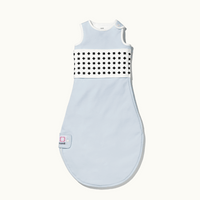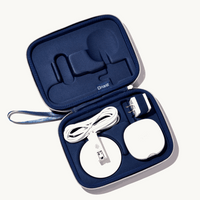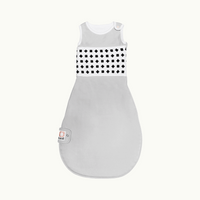The inherent benefits of yoga – increased muscle strength, boosted circulation, better sleep, etc. – are amplified during pregnancy. Maintaining or commencing a safe, gentle practice during gestation can help you relieve aches, connect with your breath during labor, and remain attuned to your developing physique.
During the different stages of pregnancy, certain poses are safer than others. The one constant? Focusing on self-compassion and health, rather than hitting those strenuous marks you might be used to. Go slowly, use your breath to guide you, and trust your instinct on whether or not a movement is beneficial for you.
Yoga Poses for the First Trimester:
It’s the great irony of your first trimester: You’re hardly showing, yet you have to be especially conscientious of what’s inside your budding belly. The first ten weeks in particular hold the highest risk for miscarriage, meaning any physical activity you do engage in should encourage, rather than hinder, implantation of the fetus and placenta.
For both seasoned yogis and new practitioners alike, an extremely gentle approach is recommended throughout the first trimester. Take care to avoid contraindication poses and inversions. If yoga proves too trying during the fickle first semester, skip the physical poses altogether and focus on breathwork instead (below).
-
Cobra Pose (Bhujangasana)
Deb Flashenberg, director of the Prenatal Yoga Center in New York City, says bhujangasana is safe, so long as you’re careful to avoid pressure on your lower belly. Plus, your first trimester is generally the last time the fetus is small enough that it won’t obstruct the flow of this empowering pose.
Lying flat on your stomach, place your palms on the ground directly under your shoulders. Bend your elbows straight back, and “hug” them into your sides. Grounding your pubic bone, inhale to lift your chest off the floor. Keeping your gaze on the floor and your lower back elongated, roll your shoulders back. Don’t let your elbows stray out too far to the side. Exhale to gently release.
-
Cross-Legged Twist (Parivrtta Sukhasana)
The low, pleasant pressure of open-seated twists make them perfect for releasing tension and relieving lower back aches. They also foster proper posture as your body transitions. (Closed twists, on the other hand, should be avoided, as they squish the uterine area.)
Do You Yoga recommends this cross-legged twist for the first trimester. Start on the floor with your legs comfortably crossed. On inhale, bring your arms up. As you exhale, bring your right arm behind you and place your left arm on your right leg. Drawing from your rib cage, shoulders, and neck, twist ever so gently to your right – and leave your belly and hips facing forward. After five or six breaths, repeat on the other side.
Yoga Poses for the Second Trimester:
As the notoriously forgiving “honeymoon period,” the second trimester is likely when you’ll feel the most inclined to work out. Pay close attention to your personal limits, though, and always drink plenty of water before, during, and after exercise. Hunger pangs are normal during the second trimester; for an energy boost, eat a light meal or snack about an hour before any activity.
-
Cat-Cow Stretch (Chakravakasana)
This gentle back-and-forth is a relief and full-body prep in one. Not only does it relieve the lower back by shifting the weight of the baby away from the spine, but it’s also reputed to boost energy and support breast milk production. It may also help turn a breech baby.
Start on your hands and knees. Keeping your neck long, align your wrists underneath your shoulders, and your knees underneath your hips. On inhale, go for cow by dropping your belly, curling your toes, and letting your chest forward. Keep your head in a neutral position, and elongate your neck as an extension of your spine. On exhale, release your toes as you segue into cat. Round your spine upwards, draw your navel inwards, and allow your head and neck to gently follow.
-
Monkey Twist (Markatasana)
This movement, recommended by Art of Living, has a number of second-trimester benefits. It stretches the entire spine, and is reputed to ease constipation and improve digestion. After 16 weeks, pay close attention to your body’s limit (typically 5-10 minutes) for this and any other backside-down positions.
While lying on your back, interlock your fingers and place your hands beneath your head. Bend your knees and keep the soles of your feet at the side edges of your mat. Upon exhale, lower your knees halfway towards the floor on your right side. Meanwhile, turn your head towards the left for a gentle spine twist. Upon inhale, bring your legs and head towards the center. Repeat on the opposite side.
-
Single-Leg Forward Bend (Janu Sirsasana)
This pose, courtesy of Mary Barnes, the Family Programming Manager at Pure Yoga in New York City, is safe at any point in your pregnancy. However, you may find it especially helpful during the second trimester, when leg cramps and hip/pelvis aches are common.
Sit up tall with your right leg extended and toes flexed back towards you. Place the left foot to your inner thigh. If your back feels tight, or you’re rounding forward, sit up on a folded yoga blanket to help your sit-bones draw back and apart. Inhale to lengthen upward and make space for your baby, and exhale to bow forward from the hips. Hands can be placed on the floor on either side of your leg, or take hold of your foot with your hands if you’re able to. Close your eyes and focus on deepening your breath.
Yoga Poses for the Third Trimester:
By the third trimester, you basically have a partner there with you on the mat. Your baby’s constant kicking and twisting can be distracting – which is exactly where yoga comes in. An active practice can help you both strengthen and relax your body in order to mentally and physically prepare for childbirth. In this period, you want to be focusing on apana vayu, the downward flowing energy.
-
Child Pose (Bālāsana)
It’s fitting that, as you approach birth, the child pose is one of the most comfortable, accessible positions. To accommodate your belly, Spoiled Yogi recommends modifying the move by supporting your torso on a bolster or stack of folded blankets.
To get into child pose, start on your hands and knees. Keep your wrists directly under your shoulders and your knees under your hips. While your big toes are touching, open your knees wide. Breathe in deeply, and upon exhaling, lower your hips towards your heels and let your forehead rest on the floor. Extend your arms in front of you.
-
The Side-Lying Savasana
The famously tranquil savasana is the perfect punctuation to any flow – and prenatal yoga is no exception. But rather than lying on your back, à la typical savasana, Flashenberg advises lying on whichever of your sides is more comfortable. Elevate your top leg on a block or a bolster, so that the knee, shin, and ankle are at a 90 degree angle and in line with the top hip. With the top leg propped, you can roll safely towards your belly, without rolling onto it.
Mindfulness Practices that are Safe Throughout Pregnancy:
Breathing exercises can be either a complement or standalone alternative to yoga. They’re also a staple of mindfulness, which is purported to hold multiple benefits during pregnancy – including reducing stress, boosting positive feelings, potentially preventing premature birth, and promoting an infant’s healthy post-birth development.
-
Explore the Multiple Approaches to Mindfulness
While a certain degree of fear is all but inevitable during pregnancy, mindfulness is an effective coping mechanism that’s accessible 24/7.
Active mindfulness can help you wrangle the stigmatized hallmarks of pregnancy, such as anxiety, depression, and stress. You might opt to enroll in a mindfulness course, or pursue your own practice (perhaps with the assistance of an app like Expectful). Try taking mindful walks guided by Stop Breathe Think, or simply engage all your senses to ground yourself in the present.
-
Do a Quick (or Long) Body Scan
Whether you’re confined to bed rest or fatigued from the steady fluctuations of pregnancy, a body scan is a great way to recharge and reconnect to better understand what your body is telling you.
You can do a systematic scan from head to toe (or vice versa). Alternatively, choose to focus on random parts of your body for short intervals. A guided audio may prove useful, too – the Mindful Awareness Research Center (MARC) at UCLA has a short, step-by-step body scan primer.
-
Explore Pranayama
An alternative to the “hee-hee-ho” breathing of Lamaze, pranayama – or the regulation of breath through controlling techniques and exercises – is more concentrated on deep-belly breathing. Types vary, but Yoga Journal recommends ujjayi for expectant mothers.
To practice ujjayi, begin sitting in a comfortable position so that your body can fully relax. Close your lips, then breathe slowly and deeply, in and out, through your nostrils. As you progress, constrict the muscles at the back of your throat (as though you were whispering) and exhale slowly through your nose, making an ocean-like sound.
—
Remember to discuss any new exercises or routines with your obstetrician. When commencing your home practice, find a flow that works for you, and remember to enjoy it! After all, anything that brings you peace, tranquility, and a chance to catch your breath will be beneficial for you and your blossoming yogi.













































